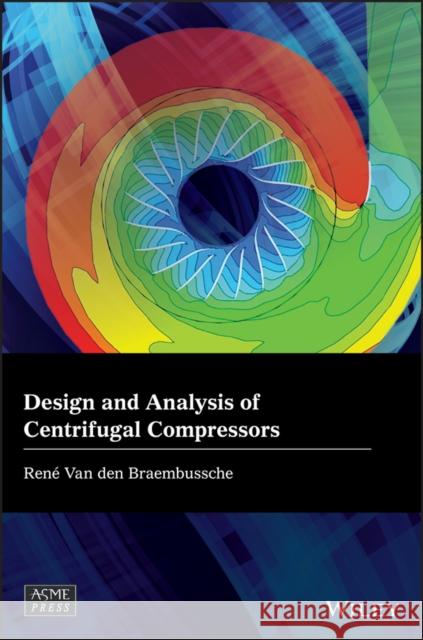Design and Analysis of Centrifugal Compressors » książka



Design and Analysis of Centrifugal Compressors
ISBN-13: 9781119424093 / Angielski / Twarda / 2019 / 408 str.
Design and Analysis of Centrifugal Compressors
ISBN-13: 9781119424093 / Angielski / Twarda / 2019 / 408 str.
(netto: 537,66 VAT: 5%)
Najniższa cena z 30 dni: 558,77
ok. 30 dni roboczych
Dostawa w 2026 r.
Darmowa dostawa!
Preface xiAcknowledgements xiiiList of Symbols xv1 Introduction 11.1 Application of Centrifugal Compressors 21.2 Achievable Efficiency 51.3 Diabatic Flows 141.4 Transformation of Energy in Radial Compressors 191.5 Performance Map 251.5.1 Theoretical Performance Curve 251.5.2 Finite Number of Blades 261.5.3 Real Performance Curve 281.6 Degree of Reaction 291.7 Operating Conditions 322 Compressor Inlets 372.1 Inlet Guide Vanes 372.1.1 Influence of Prerotation on Pressure Ratio 402.1.2 Design of IGVs 412.2 The Inducer 492.2.1 Calculation of the Inlet 502.2.1.1 Determination of the Inducer Shroud Radius 512.2.2 Optimum Incidence Angle 532.2.3 Inducer Choking Mass Flow 563 Radial Impeller Flow Calculation 613.1 Inviscid Impeller Flow Calculation 633.1.1 Meridional Velocity Calculation 633.1.2 Blade to Blade Velocity Calculation 663.1.3 Optimal Velocity Distribution 683.2 3D Impeller Flow 733.2.1 3D Inviscid Flow 733.2.2 Boundary Layers 763.2.3 Secondary Flows 783.2.3.1 Shrouded-unshrouded 823.2.4 Full 3D Geometries 843.3 Performance Predictions 883.3.1 Flow in Divergent Channels 883.3.2 Impeller Diffusion Model 903.3.3 Two-zone Flow Model 943.3.4 Calculation of Average Flow Conditions 1013.3.5 Influence of the Wake/Jet Velocity Ratio ny on Impeller Performance 1023.4 Slip Factor 1043.5 Disk Friction 1084 The Diffuser 1134.1 Vaneless Diffusers 1164.1.1 One-dimensional Calculation 1174.1.2 Circumferential Distortion 1224.1.3 Three-dimensional Flow Calculation 1254.2 Vaned Diffusers 1314.2.1 Curved Vane Diffusers 1314.2.2 Channel Diffusers 1354.2.3 The Vaneless and Semi-vaneless Space 1364.2.4 The Diffuser Channel 1435 Detailed Geometry Design 1475.1 Inverse Design Methods 1475.1.1 Analytical Inverse Design Methods 1485.1.2 Inverse Design by CFD 1525.2 Optimization Systems 1565.2.1 Parameterized Definition of the Impeller Geometry 1575.2.2 Search Mechanisms 1595.2.2.1 Gradient Methods 1605.2.2.2 Zero-order Search Mechanisms 1615.2.2.3 Evolutionary Methods 1615.2.3 Metamodel Assisted Optimization 1645.2.4 Multiobjective and Constraint Optimization 1705.2.4.1 Multiobjective Ranking 1705.2.4.2 Constraints 1725.2.4.3 Multiobjective Design of Centrifugal Impellers 1735.2.5 Multipoint Optimization 1755.2.5.1 Design of a Low Solidity Diffuser 1755.2.5.2 Multipoint Impeller Design 1775.2.6 Robust Optimization 1816 Volutes 1856.1 Inlet Volutes 1856.1.1 Inlet Bends 1866.1.2 Inlet Volutes 1906.1.3 Vaned Inlet Volutes 1936.1.4 Tangential Inlet Volute 1946.2 Outlet Volutes 1966.2.1 Volute Flow Model 1966.2.2 Main Geometrical Parameters 1976.2.3 Detailed 3D Flow Structure in Volutes 2006.2.3.1 Design Mass Flow Operation 2016.2.3.2 Lower than Design Mass Flow 2046.2.3.3 Higher than Design Mass Flow 2056.2.4 Central Elliptic Volutes 2086.2.4.1 High Mass Flow Measurements 2106.2.4.2 Medium and Low Mass Flow Measurements 2156.2.4.3 Volute Outlet Measurements 2156.2.5 Internal Rectangular Volutes 2156.2.5.1 High Mass Flow Measurements 2166.2.5.2 Medium Mass Flow Measurements 2186.2.5.3 Low Mass Flow Measurements 2196.2.6 Volute Cross Sectional Shape 2216.2.7 Volute Performance 2226.2.7.1 Experimental Results 2246.2.7.2 Performance Predictions 2256.2.7.3 Detailed Evaluation of Volute Loss Model 2286.2.8 3D analysis of Volute Flow 2306.3 Volute-diffuser Optimization 2316.3.1 Non-axisymmetric Diffuser 2336.3.2 Increased Diffuser Exit Width 2347 Impeller Response to Outlet Distortion 2377.1 Experimental Observations 2387.2 Theoretical Predictions 2427.2.1 1D Model 2447.2.2 CFD: Mixing Plane Approach 2457.2.3 3D Unsteady Flow Calculations 2477.2.3.1 Impeller with 20 Full Blades 2487.2.3.2 Impeller with Splitter Vanes 2497.2.4 Inlet and Outlet Flow Distortion 2497.2.4.1 Parametric Study 2537.2.5 Frozen Rotor Approach 2547.3 Radial Forces 2587.3.1 Experimental Observations 2587.3.2 Computation of Radial Forces 2637.4 Off-design Performance Prediction 2677.4.1 Impeller Response Model 2687.4.2 Diffuser Response Model 2697.4.3 Volute Flow Calculation 2697.4.4 Impeller Outlet Pressure Distribution 2727.4.5 Evaluation and Conclusion 2738 Stability and Range 2758.1 Distinction Between Different Types of Rotating Stall 2768.2 Vaneless Diffuser Rotating Stall 2808.2.1 Theoretical Stability Calculation 2848.2.2 Comparison with Experiments 2878.2.3 Influence of the Diffuser Inlet Shape and Pinching 2898.3 Abrupt Impeller Rotating Stall 2968.3.1 Theoretical Prediction Models 2978.3.2 Comparison with Experimental Results 3008.4 Progressive Impeller Rotating Stall 3018.4.1 Experimental Observations 3018.5 Vaned Diffuser Rotating Stall 3078.5.1 Return Channel Rotating Stall 3148.6 Surge 3148.6.1 Lumped Parameter Surge Model 3168.6.2 Mild Versus Deep Surge 3218.6.3 An Alternative Surge Prediction Model 3259 Operating Range 3299.1 Active Surge Control 3309.1.1 Throttle Valve Control 3319.1.2 Variable Plenum Control 3339.1.3 Active Magnetic Bearings 3359.1.4 Close-coupled Resistance 3369.2 Bypass Valves 3379.3 Increased Impeller Stability 3409.3.1 Dual Entry Compressors 3429.3.2 Casing Treatment 3449.4 Enhanced Vaned Diffuser Stability 3479.5 Impeller-diffuser Matching 3519.6 Enhanced Vaneless Diffuser Stability 3549.6.1 Low Solidity Vaned Diffusers 3569.6.2 Half-height Vanes 3599.6.3 Rotating Vaneless Diffusers 359Bibliography 363Index 385
René Van den Braembussche is an Honorary professor at the von Karman Institute, Belgium. He is the principal investigator of funded research on centrifugal compressor design and testing, and compressor and turbine design and performance prediction. He is also a retired fellow of ASME.
1997-2025 DolnySlask.com Agencja Internetowa
KrainaKsiazek.PL - Księgarnia Internetowa









